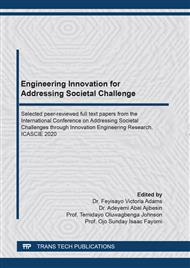[1]
Shodja, H.M., Kiani, K., Hashemian, A., A model for the evolution of concrete deterioration due to reinforcement corrosion, Math. Comput. Model. 52 (2010) 1403–1422.
DOI: 10.1016/j.mcm.2010.05.023
Google Scholar
[2]
Val, D.V., Chernin, L., Stewart, M.G., Experimental and numerical investigation of corrosion-induced cover cracking in reinforced concrete structures. J. Struct. Eng. 135 (2009) 376–385.
DOI: 10.1061/(asce)0733-9445(2009)135:4(376)
Google Scholar
[3]
Lu, C.H., Liu, R.G., Jin, W.L., A model for predicting time to corrosion-induced cover cracking in reinforced concrete structures, In Fracture Mechanics of Concrete and Concrete Structures Assessment, Durability, Monitoring and Retrofitting of Concrete Structures, CRC Press, Boca Raton, FL, USA (2010) 967–975.
DOI: 10.5703/1288284316150
Google Scholar
[4]
Lau, I., Time-Dependent Reliability Analysis of Corrosion-Induced Concrete Cracking Based on Fracture Mechanics Criteria. Ph.D. Thesis, RMIT University, Melbourne, Australia (2019).
Google Scholar
[5]
Lau, I., Li, C.-Q., Fu, G. Prediction of time to corrosion-induced concrete cracking based on fracture mechanics criteria, J. Struct. Eng. 145 (2019) 04019069.
DOI: 10.1061/(asce)st.1943-541x.0002352
Google Scholar
[6]
Coccia, S., Imperatore, S., Rinaldi, Z., Influence of corrosion on the bond strength of steel rebars in concrete, Mater. Struct., 49 (2016) 537–551.
DOI: 10.1617/s11527-014-0518-x
Google Scholar
[7]
Shen, J., Gao, X., Li, B., Du, K., Jin, R., Chen, W., Xu, Y., Damage evolution of RC beams under simultaneous reinforcement corrosion and sustained load, Materials 12 (2019) 627.
DOI: 10.3390/ma12040627
Google Scholar
[8]
Song, L., Fan, Z., Hou, J., Experimental and analytical investigation of the fatigue flexural behavior of corroded reinforced concrete beams, Int. J. Concr. Struct. Mater., 13 (2019) 24.
DOI: 10.1186/s40069-019-0340-5
Google Scholar
[9]
Bossio, A., Fabbrocino, F., Monetta, T., Lignola, G.P., Prota, A., Manfredi, G., Bellucci, F. Corrosion effects on seismic capacity of reinforced concrete structures, Corros. Rev. 37 (2019) 45–56.
DOI: 10.1515/corrrev-2018-0044
Google Scholar
[10]
Cui, Z., Alipour, A., Shafei, B. Structural performance of deteriorating reinforced concrete columns under multiple earthquake events. Eng. Struct. 191 (2019) 460–468.
DOI: 10.1016/j.engstruct.2019.04.073
Google Scholar
[11]
Apostolopoulos, C.A., Koulouris, K.F., Apostolopoulos, A.C., Correlation of surface cracks of concrete due to corrosion and bond strength (between Steel Bar and Concrete)., Adv. Civ. Eng. 2019 (2019) 3438743.
DOI: 10.1155/2019/3438743
Google Scholar
[12]
Okazaki, S., Okuma, C., Kurumatani, M., Yoshida, H., Matsushima, M., Predicting the Width of Corrosion-Induced Cracks in Reinforced Concrete Using a Damage Model Based on Fracture Mechanics, applied sciences 10,15 (2020) 5272.
DOI: 10.3390/app10155272
Google Scholar
[13]
Hashiguchi, K., Aida, R., Kurumatani, M., Okazaki, S., High Resolutional 3D-DIC Measurement System and Accuracy Verification for Concrete Specimens, J. JSCE A2 22.2 (2019) I_313-I_321.
DOI: 10.2208/jscejam.75.2_i_313
Google Scholar
[14]
Kabeyama, Y., Fujimura, S., Okuma, C., Okazaki, S., Kurumatani, M., J. JSCE B3 75.2 (2019) I_875-I_880.
Google Scholar


